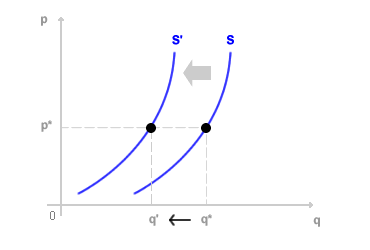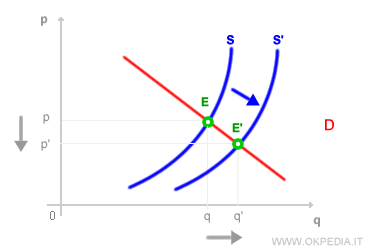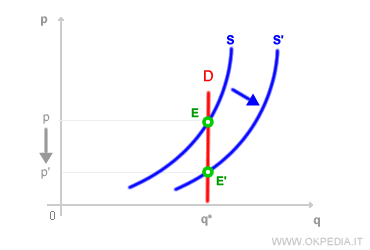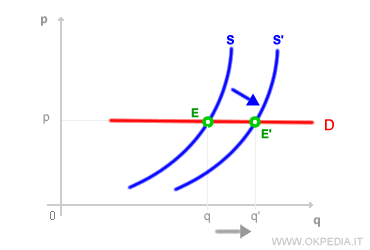Shifts in the Supply Curve
Shifts in the supply curve refer to movements of the supply function on a Cartesian plane. The supply curve can shift to the right or the left.
A supply curve shift occurs when the quantity of a good supplied changes at every price level.
Expansion and Contraction of Supply
Typically, a decrease in production costs causes the supply curve to shift to the right, while an increase in production costs pushes it to the left.
- Expansion of supply. The supply curve expands when a technological innovation improves machinery efficiency, lowering production costs. This results in a rightward shift of the supply curve. Lower costs enable businesses to produce a greater quantity (Q) at the same price.

The same effect can occur with the introduction of incentives or tax cuts, both of which reduce production costs. Similarly, lower labor or borrowing costs lead to decreased production expenses and, consequently, a rightward shift in the supply curve.
- Contraction of supply. The supply curve shifts to the left when the opposite conditions apply. If production costs rise while the selling price (p) remains unchanged, businesses reduce their output. This leads to a leftward shift of the supply curve.

Causes of Supply Curve Shifts
Various factors can trigger these shifts.
The supply curve may shift under the following circumstances:
- Changes in the cost of production inputs. When the cost of a production input (e.g., labor, raw materials, energy) increases, businesses supply less of the good at every price level. Conversely, a reduction in input costs has the opposite effect.
- Changes in the price of an alternative good. If a company produces two goods, A and B, and the price of good B rises, the supply of good A may decrease as the company reallocates resources to produce more of good B. The reverse is also true.
- Anticipated changes in the price of the good. If a company expects the price of a good to increase in the future (t+1), it may adjust current supply (t) to capitalize on anticipated conditions.
Impacts on Market Equilibrium
Shifts in the supply curve have indirect effects on market equilibrium.
The ultimate impact on price (p) and production quantity (q) is determined by market dynamics.
Market equilibrium depends not only on the position of the supply curve but also on demand conditions.

It is essential to consider the demand curve alongside the supply curve.
Example: Inelastic Demand
In the case of inelastic demand (a vertical demand curve), an increase in production (+ΔQ) results in a decrease in market price (-ΔP).

The market equilibrium shifts from E to E'.
Example: Elastic Demand
With perfectly elastic demand (a horizontal demand curve), an increase in production (+ΔQ) does not affect the market price (p) but increases the quantity exchanged (q') of the economic good.

The market equilibrium shifts from E to E'.
